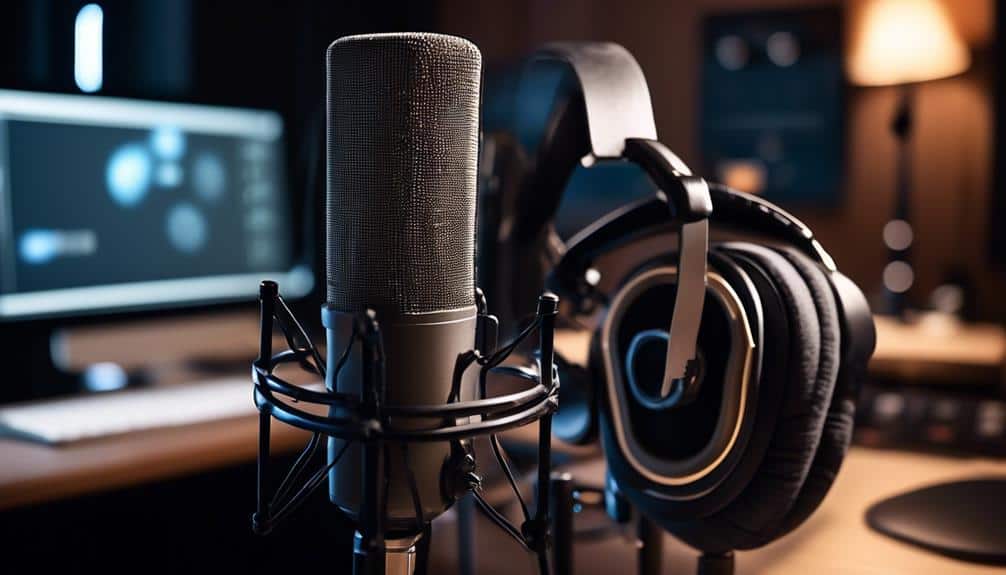Podcast Production Essentials: Recording Tips for Crystal-Clear Audio
Imagine capturing the pure essence of your podcast guests' voices, every nuanced inflection and tone, in a way that draws listeners in effortlessly. To achieve this level of audio quality, you need to pay close attention to the recording process.
From selecting the right microphone to mastering mic placement techniques, each step plays a crucial role in delivering crystal-clear audio to your audience. As you embark on this journey to refine your podcast production skills, the following discussion will equip you with essential recording tips that can elevate the overall quality of your podcast episodes and keep your audience engaged from start to finish.
Key Takeaways
- Choose the right microphone based on sensitivity and polar pattern to suit recording needs.
- Optimize recording space with acoustic treatment and soundproofing techniques for clean audio capture.
- Maintain equipment regularly, adjust settings carefully, and monitor audio signals for optimal sound quality.
- Utilize editing techniques such as noise reduction and equalization for professional-grade audio clarity.
Selecting the Right Microphone
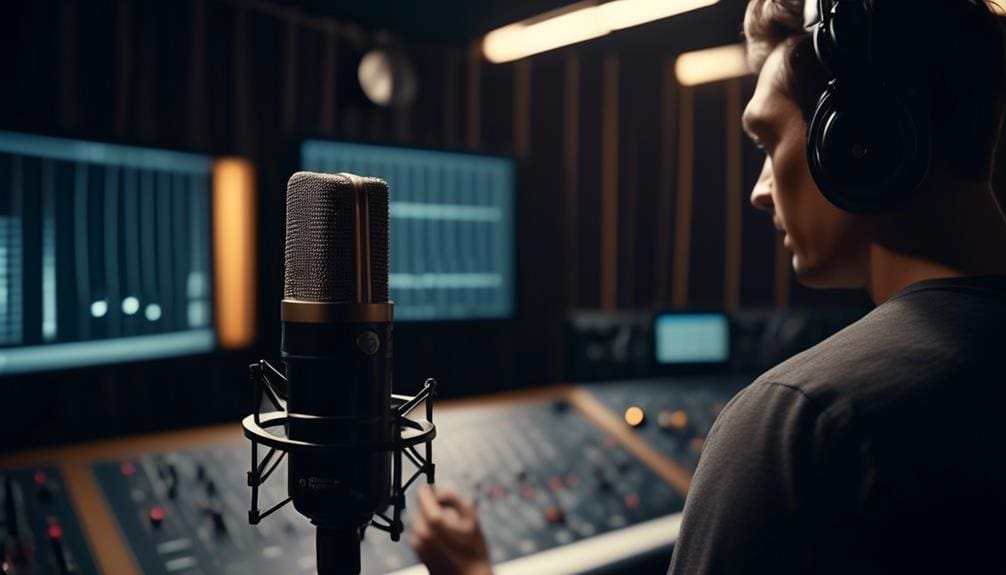
To capture the best sound quality, choose a microphone that matches the specific needs of your recording environment and desired audio characteristics. When selecting a microphone, two crucial factors to consider are microphone sensitivity and the polar pattern.
Microphone sensitivity refers to how well the microphone converts sound into an electrical signal. A microphone with high sensitivity will capture even the most subtle sounds, making it ideal for quiet recording environments. On the other hand, a microphone with low sensitivity is better suited for loud environments to prevent distortion.
Another essential consideration is the polar pattern of the microphone, which determines the direction from which the microphone will pick up sound. For example, a cardioid polar pattern captures sound from the front while minimizing background noise—perfect for solo podcasts or recordings in noisy environments.
Understanding these characteristics will help you select the right microphone for your specific recording needs, ensuring crystal-clear audio every time.
Understanding Acoustic Treatment
Consider the impact of acoustic treatment on your recording space's sound quality to optimize audio clarity and minimize unwanted reflections. When it comes to creating a professional recording environment, understanding how sound behaves in your space is crucial. Here are some key points to help you enhance your recording setup:
- Soundproofing Materials: Invest in soundproofing materials like acoustic panels, bass traps, and diffusers to reduce outside noise interference and internal sound reflections. These materials can significantly improve the overall sound quality of your recordings by minimizing echo and reverberation.
- Room Resonance: Identify and address any room resonance issues by strategically placing acoustic treatment in areas where sound waves tend to reflect and amplify. This will help in eliminating unwanted frequencies and creating a more balanced sound environment for your recordings.
- Professional Advice: Consider seeking professional advice or consulting with acoustic experts to tailor the acoustic treatment to your specific recording space. Their expertise can guide you in choosing the right materials and placement techniques to achieve optimal audio quality.
Mastering Mic Placement Techniques
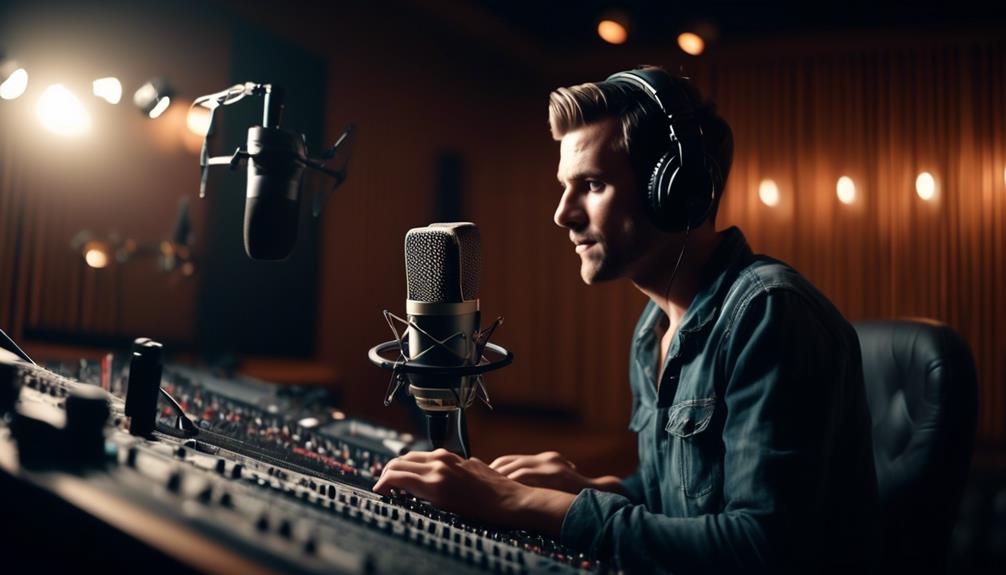
Optimize your recording setup by mastering mic placement techniques to complement the impact of acoustic treatment on your sound quality. When considering mic placement, take into account your room acoustics and the level of sound isolation required for your recording environment. Place the microphone at a distance from reflective surfaces to minimize unwanted echoes and reverberations. Experiment with positioning the mic slightly off-center from your mouth to reduce plosives and sibilance.
To enhance sound isolation, use a directional microphone to focus on capturing your voice while minimizing background noise. Position the mic close enough to achieve a good signal-to-noise ratio but far enough to prevent clipping or distortion. Utilize pop filters to reduce harsh consonant sounds and maintain a consistent distance from the microphone for a uniform sound quality throughout your recording.
Setting Up a Quiet Recording Space
Creating a noise-free environment is essential for achieving optimal recording conditions. To set up a quiet recording space, consider the following:
- Soundproofing Techniques
- Use acoustic foam panels on walls to absorb sound waves and reduce reflections.
- Seal gaps around doors and windows with weather stripping to prevent outside noise from entering.
- Consider using a noise isolation shield around your microphone to minimize background noise.
Proper room acoustics play a crucial role in capturing clean audio for your podcast. By implementing soundproofing techniques and optimizing room acoustics, you can create a quiet recording space that enhances the overall quality of your audio recordings.
Optimizing Recording Levels
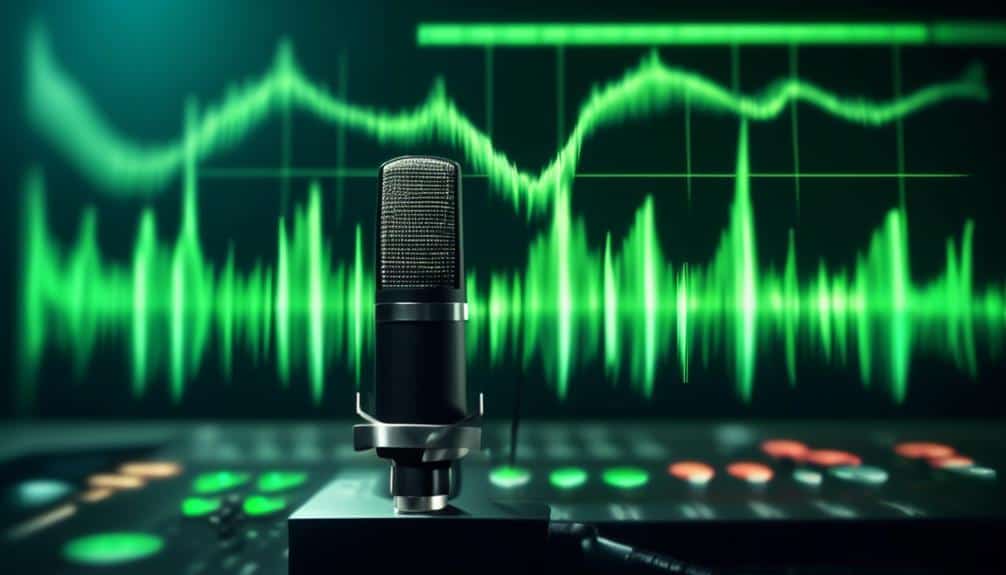
To ensure optimal recording levels, it's crucial to carefully set your input levels, keeping them high enough to capture sound accurately without causing distortion.
Monitoring audio signals in real-time allows you to make adjustments on-the-fly to prevent any clipping distortion and maintain crystal-clear audio quality during recording sessions.
Setting Input Levels
Adjust your input levels carefully to ensure optimal recording quality. When setting input levels for your podcast recording, pay attention to the following:
- Avoid clipping: Prevent distortion by ensuring your input levels don't peak into the red zone.
- Maintain headroom: Leave some room between your signal and the maximum level to allow for dynamic range.
- Noise reduction: Set levels high enough to capture your audio clearly but low enough to minimize background noise.
Monitoring Audio Signals
For optimal recording levels, it's crucial to monitor your audio signals closely during the recording process. Utilize monitoring techniques such as peak meters, VU meters, or digital level meters to analyze your signal levels in real-time.
Peak meters display the highest point of your signal, helping prevent distortion by ensuring levels don't exceed 0 dB. VU meters provide a more average level of your audio signal, aiding in maintaining consistent levels. Digital level meters offer precise numerical values for accurate signal analysis.
Adjust input levels accordingly based on the feedback from these monitoring tools to optimize recording quality. By employing these monitoring techniques, you can achieve crystal-clear audio recordings with balanced and distortion-free sound.
Avoiding Clipping Distortion
When optimizing recording levels to avoid clipping distortion, ensure that your audio signal doesn't exceed the maximum threshold to maintain clarity and prevent sound distortion.
To prevent audio overload and master audio balance effectively, follow these essential tips:
- Set Proper Input Levels: Adjust the input levels on your recording device to ensure that the audio signal is strong but not peaking into the red zone.
- Monitor Levels Continuously: Keep an eye on your levels throughout the recording process to catch any sudden spikes that could lead to clipping.
- Use a Pop Filter: Position a pop filter in front of your microphone to minimize sudden loud sounds that can cause distortion.
Utilizing Pop Filters and Windscreens
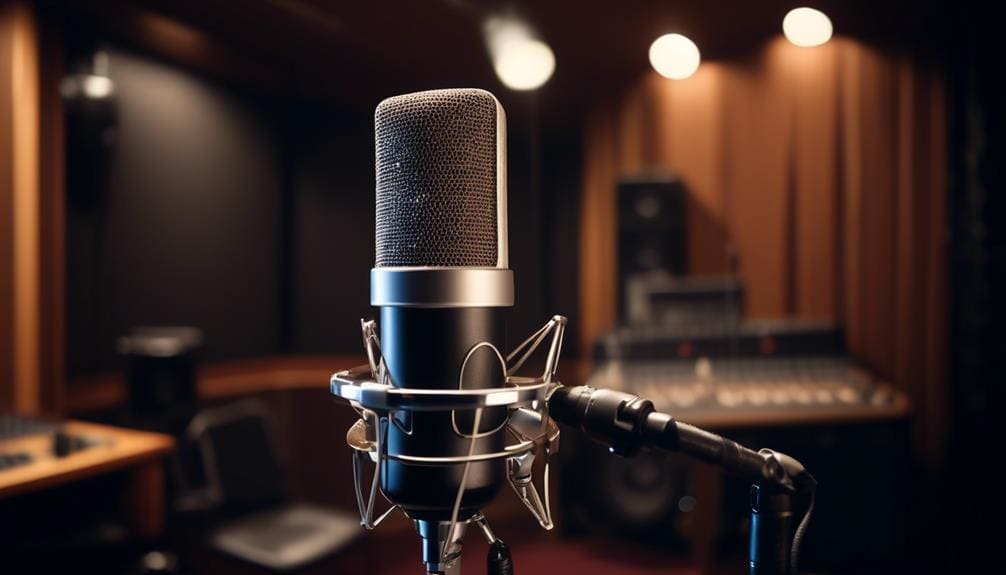
To ensure optimal sound quality and reduce unwanted noise in your recordings, consider employing pop filters and windscreens.
Pop filters are essential accessories that help prevent plosive sounds, like 'p' and 'b,' from distorting your audio. When choosing equipment, ensure the pop filter is compatible with your microphone to effectively minimize these sounds.
Windscreens, on the other hand, are designed to reduce background noise, such as wind interference, ensuring a cleaner recording. It's crucial to maintain cleanliness by regularly cleaning your pop filter and windscreen to prevent the build-up of dust and debris that can affect sound quality.
When cleaning, gently remove any dirt or particles using a soft brush or cloth to avoid damaging the filter or screen material. By incorporating pop filters and windscreens into your recording setup and keeping them clean, you can achieve crystal-clear audio for your podcasts, enhancing the overall listening experience for your audience.
Monitoring and Adjusting Audio Settings
In order to ensure your recordings maintain high-quality sound and minimize unwanted noise, attention to monitoring and adjusting audio settings is crucial. When it comes to podcast production, the following tips will help you achieve the best audio quality:
- Volume control: Keep an eye on your recording levels to prevent distortion or overly quiet audio. Adjust the input volume on your microphone or audio interface to ensure a clear and balanced sound.
- Equalizer settings: Experiment with the equalizer settings to enhance the overall sound of your recordings. Tweak the frequencies to emphasize vocals or reduce background noise, helping you achieve a more polished and professional sound.
- Monitoring tools: Utilize headphones or studio monitors to accurately hear the audio you're recording. Monitoring in real-time allows you to make immediate adjustments to levels, EQ, and other settings to ensure optimal audio quality in your podcasts.
Editing for Clarity and Consistency
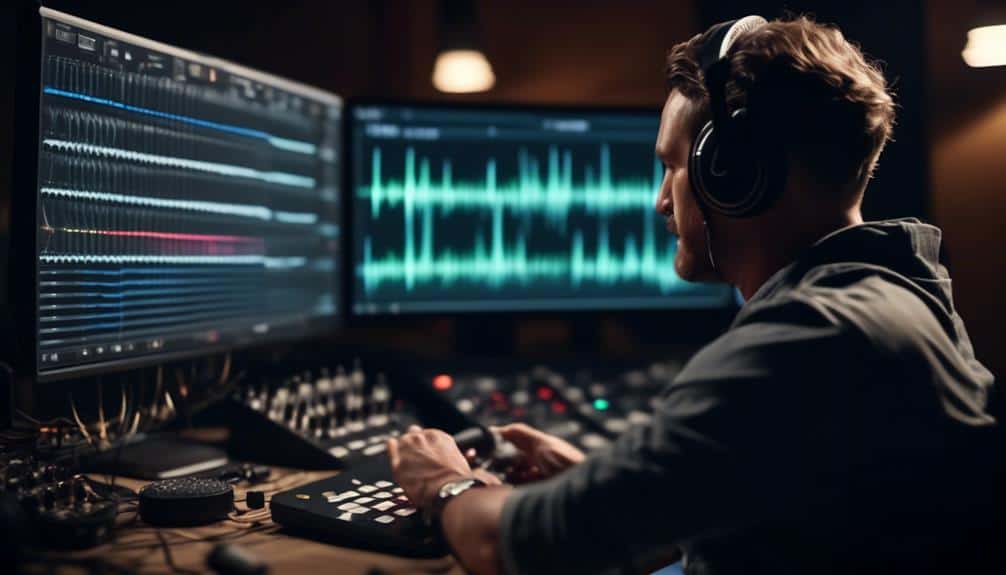
For achieving professional-grade audio quality in your podcasts, precise editing techniques are essential to ensure clarity and consistency throughout the recording.
When editing your podcast, start by employing noise reduction techniques to eliminate unwanted background sounds that may distract your listeners. Use audio editing software to carefully remove any hisses, hums, or other disturbances while preserving the natural quality of the voice.
Additionally, consider utilizing equalization tips to balance the frequencies in your audio. Adjusting the highs, mids, and lows can enhance the overall sound quality and make the voices more distinct and pleasant to listen to.
Volume balancing is another crucial aspect of editing for clarity and consistency. Ensure that the volume levels of different audio tracks are harmonized to prevent sudden jumps or drops in sound that can disrupt the listener's experience.
Frequently Asked Questions
How Can I Prevent Background Noise From Interfering With My Podcast Recordings?
To prevent background noise during podcast recordings, ensure optimal microphone placement, consider soundproofing materials, and improve room acoustics. Utilize noise cancellation techniques to enhance audio quality and minimize unwanted disturbances, creating a professional podcast experience.
Are There Any Specific Techniques for Reducing Sibilance in Vocal Recordings?
To reduce sibilance in vocal recordings, adjust your microphone setup. Try vocal EQ tips to tame harsh sounds. Use a pop filter to lessen plosive sounds. Experiment with positioning and settings for smoother, clearer audio.
What Software Do You Recommend for Editing Podcasts and Cleaning up Audio?
When editing podcasts and cleaning up audio, consider using software like Adobe Audition or Audacity. These tools offer audio restoration options and noise reduction techniques that can enhance your podcast editing workflow and streamline the audio mastering process.
How Can I Ensure a Consistent Audio Quality Across All Episodes of My Podcast?
To ensure consistent audio quality for your podcast, focus on maintaining equipment and troubleshooting issues promptly. Implementing a standardized recording setup, regular sound checks, and adhering to branding guidelines will help maintain a professional sound across all episodes.
What Are Some Common Mistakes to Avoid When Recording Podcasts to Ensure the Best Sound Quality?
To ensure the best sound quality when recording podcasts, avoid common mistakes like improper microphone placement and neglecting room acoustics. Place the microphone correctly and address room acoustics for crystal-clear audio.
Conclusion
In conclusion, by following these podcast production essentials, you can ensure crystal-clear audio quality for your recordings.
From selecting the right microphone to mastering mic placement techniques and optimizing recording levels, each step plays a crucial role in achieving professional sound.
Remember to pay attention to acoustic treatment, quiet recording spaces, and use pop filters and windscreens.
With careful monitoring and adjustments, along with precise editing, you can produce high-quality podcasts that captivate your audience.
